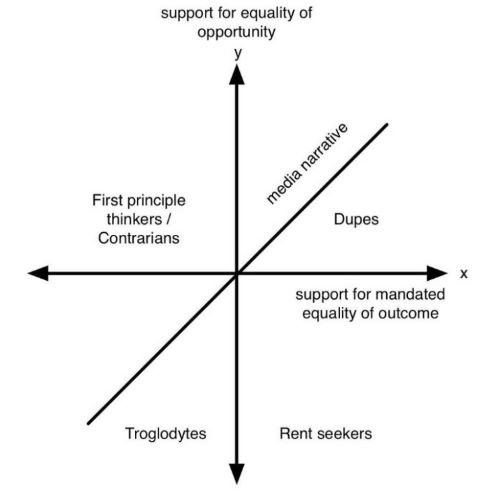Difference between revisions of "The Four Quadrant Model"
| Line 5: | Line 5: | ||
<br> | <br> | ||
=== Definitions === | === Definitions === | ||
1. The | 1.The "Dupes": People who believe they can infer someone’s true intentions, beliefs or morality based on their support for, or opposition to, the policy initiative. | ||
2. “First principle thinkers” or “contrarians”: They hold nuanced positions that oppose the policy on the x-axis, but support the moral virtue on the y-axis. In the words of Eric Weinstein, “These are people who are thinking for themselves, and are not buying baked-cakes. They’re buying the ingredients and they’re saying, well, I want more of this ingredient, I don’t like that ingredient. So they’re attempting to avoid having any pre-baked idea put in front of them.” | 2. “First principle thinkers” or “contrarians”: They hold nuanced positions that oppose the policy on the x-axis, but support the moral virtue on the y-axis. In the words of Eric Weinstein, “These are people who are thinking for themselves, and are not buying baked-cakes. They’re buying the ingredients and they’re saying, well, I want more of this ingredient, I don’t like that ingredient. So they’re attempting to avoid having any pre-baked idea put in front of them.” | ||
3. “Troglodytes”: Those who oppose the x-axis policy and possess the moral vice represented by the lower-half of the y-axis (e.g. sexists, racists, etc). | 3. “Troglodytes”: Those who oppose the x-axis policy and possess the moral vice represented by the lower-half of the y-axis (e.g. sexists, racists, etc). | ||
4. “Rent seekers”: "Woke" people or companies who have a vested-interest in the x-axis policy because they profit from it, but do not produce much or anything of value in return. | 4. “Rent seekers”: "Woke" people or companies who have a vested-interest in the x-axis policy because they profit from it, but do not produce much or anything of value in return. | ||
=== Visual Explanation === | === Visual Explanation === | ||
[[File:FQM.jpg|frame|center|The Four Quadrant Model]] | [[File:FQM.jpg|frame|center|The Four Quadrant Model]] | ||
Revision as of 16:34, 6 August 2020
The Four Quadrant Model
What Is It?
In broad terms, the model is a tool for illustrating how the media stigmatizes certain nuanced views that challenge the status quo by portraying people who hold those views as prejudiced or intolerant.
Definitions
1.The "Dupes": People who believe they can infer someone’s true intentions, beliefs or morality based on their support for, or opposition to, the policy initiative.
2. “First principle thinkers” or “contrarians”: They hold nuanced positions that oppose the policy on the x-axis, but support the moral virtue on the y-axis. In the words of Eric Weinstein, “These are people who are thinking for themselves, and are not buying baked-cakes. They’re buying the ingredients and they’re saying, well, I want more of this ingredient, I don’t like that ingredient. So they’re attempting to avoid having any pre-baked idea put in front of them.”
3. “Troglodytes”: Those who oppose the x-axis policy and possess the moral vice represented by the lower-half of the y-axis (e.g. sexists, racists, etc).
4. “Rent seekers”: "Woke" people or companies who have a vested-interest in the x-axis policy because they profit from it, but do not produce much or anything of value in return.
